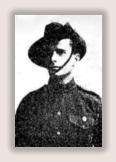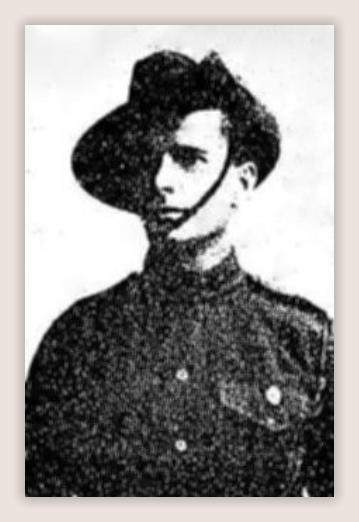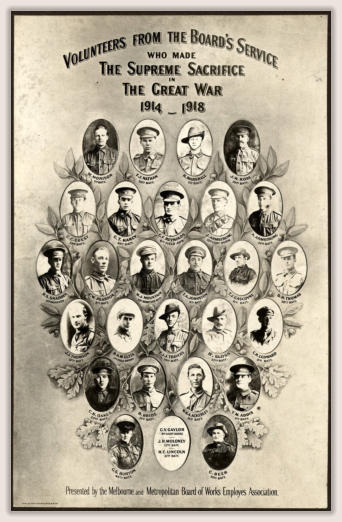Their bodies are buried in peace; but their names liveth for evermore.
Their Duty Done
A tribute to the men and women of the East Gippsland Region who Died
as a result of their participation in World War One : 1914 -1919


3261 Corporal Garnet Victor Stanhope Gaylor - Bairnsdale
Killed in Action 4 May 1918
Garnet Victor Stanhope Gaylor, known as George, was the tenth of eleven children
born to William and Sarah Gaylor. The Gaylors were well known in Hobart. William
was a reputable goldsmith and jeweller in Hobart and also recognized as a marine
watercolourist. It was perhaps this business that saw the family travel across to
Victoria with some regularity. In 1870 their fourth child died in Melbourne before they
returned to Hobart. In 1872 George and his brother Albert had a bitter and public
falling out over their business. In 1875 George and his wife and six children were
temporarily in Victoria where another child was born before they returned again to
Tasmania in late 1876. Garnet’s brother, Tasman who also served in the war, was born
in Hobart in 1878 but it appears the family feud still existed as the Gaynors sold all
their belongings and moved back to Victoria the following year. Garnet was born at
Emerald Hill 31 August 1880 and the last child two years later.
But troubled times were ahead for the family. George applied for insolvency in
1881 after being caught up in the collapse of the Provincial Bank and the unwise
investment of £3,000. Then three years later, on 22 April 1884, George dies aged 47
years followed by Sarah in 1900 when she was 57 years old.
The five unmarried adult children continued living in the family home in
Glenhuntly Road, Elsternwick for many years where Garnet was working for the
Melbourne Metropolitation Board of Works. In 1903, Tasman almost drowned when
fishing of Elwood beach. Heavy weather set in and his boat capsized and sank when he
was putting her about. He had started to swim to shore when a couple of boats set out
to rescue him. Due to the conditions the first rescue boat could not get close enough to
him, the second being able to grab his shoulder as he sank for the first time completely
exhausted. It is speculated that it was Garnet who grabbed his exhausted brother.
Garnet had been working as a clerk and would have been reading in the papers
of the Boer War in South Africa, when, at 25 years of age, he made the decision to leave
Victoria. He arrived in Johannesburg, South Africa in January 1906 and joined the
South African Constabulary on 1 February serving in the Transvaal and Orange River
colony. He is described as being in good physical condition, blue eyes with a fresh
complexion and light hair. Unusually his appearance was described as “smart”. He was
recruited as a Constable for three years and paid five shillings a day. However, on 16
September 1907, just 1 year 228 days later, he was discharged free his conduct
recorded as being of good character. He was released from Rustenburg, South Africa
and sailed home on the Marama the following month returning to the family home in
Elsternwick.
By 1912 Garnet had moved to Main Street Bairnsdale and employed as a
buttermaker. During this time Garnet was a member of the Bairnsdale Rowing Club
and participated in many rowing regattas with fellow war recruits, and started working
as a telegraph technician. One month shy of his 29
th
birthday, Garnet enlisted on 5
July 1915 joining the 10
th
Light Horse. When undertaking his medical it was noted that
Garnet had several tattoos, probably from his time in South Africa, including a star,
moon and tree on his left arm and an anchor and flag on the right. He named Kitty
Catherine Johnston, of Bairnsdale, his next of kin, before his siblings.
Garnet arrived in Alexandria before being transferred to Mudros, the Gallipoli
troops being evacuated before could be landed on the peninsula. He was returned to
Alexandria and Helipolis where he was admitted to hospital before being invalided
home on 17 July 1916 due to “rheumatism” and an “irritable heart”. On 2 January 1917,
six months later he re-enlisted, this time with the 8th Light Horse and returned to
Egypt and was promoted to temporary Sergeant for the duration of April. Garnet had
several stays in hospital with septic sores and was admitted to rest camp over the rest
of 1917.
In March 1918 The Graphic of Australia paper featured photographs of the
brothers, Garnet and Tasman headed “Brothers in Arms” and reported how they were
both serving with the Light Horse in Egypt but this celebration of duty was shortlived.
At 6am on 4 May 1918, his unit was making a frontal attack on a Turkish position
in Palestine when Garnet was shot, through his steel helmet, in the forehead. The
bullet exited the rear of his skull. It was initially thought he had been killed outright,
however about fifteen minutes later, movement was noticed and the stretcher bearers
called. His was conveyed to the Turkish Hospital at Es-Salt that was under the control
of the 3
rd
Brigade Field Ambulance and once examined, his condition was regarded as
hopeless. He had been, and remained, unconscious from the time of the shot and
nothing could be done for him except to bandage his head. Fellow East Gippsland
soldier Clarence Jeffers from Lindenow was in his unit and confirmed the happenings
in a later enquiry.
Turkish forces advanced on the hospital, hunting the A.I.F. out just hours later
and they were forced to retreat and regretfully, two men were left behind, one being
Garnet Gaylor. The injured were evacuated by cacolets – double stretchers that had
been modified for camels – and doctors considered it impossible for him to be moved
while in a deep comatose. It was necessary for the camels to traverse down a very
rough mountain track, at times with the cacolets being lifted from the animals.
Questions hung over Garnet’s fate for months. Kitty Johnson and his family
feared the worse and neither could get any definitive information from the
Department. Officially he had to be “missing” four months before any enquiries could
be made even though newspapers were reporting him killed in action.
In June his sister Lily wrote we have been told he couldn’t be moved and that
any further information would immediately be sent and up to the present we have
had no word. I think we have had time to have some idea as to the poor boy’s fate. I
think it is very cruel to have to wait in such suspense, in fact I am quite ill with
worrying. I would be so grateful if you could get me some word, whether he is living
or if he succumbed to his injuries. She sent the same request to His Excellency Sir
Ronald Ferguson as she remembered his name with kindness and respect, as you
spoke to my brother so kindly the morning he was leaving P. Melb. I know it made
him happy because he mentioned it in his letter on the voyage, and how you shook his
hand and wished him God speed.
Both women were desperate for news.
The following month, Kitty received some of his personal effects including his
unloaded revolver along with two small wooden elephants and a package of fancy
writing paper. In October she also received his wallet that had been a treasured gift
from her to him.
In November 1918 Lily wrote saying she had letters from other soldiers saying
that Garnet had recovered and had been taken prisoner of war and that the German
doctor left in charge of him at the Turkish hospital had promised to take great care of
him.
In a cruel move, when enquiries were made regarding him being a possible
prisoner of war, the German Aerial Service advised the Red Cross he was still alive and
doing well, and that they had every hope of his recovery. Other prisoners of war taken
at that time however had no knowledge of him.
There was no official news until a Court of Enquiry was held in May 1919 it was
concluded that from all the enquiries made he could not have survived and therefore
died on or about the 4 May 1918.
Four months later in September 1919 his brother Tasman sought answers at Es
Salt personally. He found the Armenian sister who attended Garnet in hospital the
year before and she told him that Garnet died at noon on that day. She also told him
where he was buried. Tasman found Garnet in the mouth of a small cave on the left of
the old Christian cemetery after entering the gate. He buried him there aided by
Corporal Hardiman. He was reinterred by the graves retrieval team at the Jerusalem
military cemetery.
Garnet was 31 years old when he died. He is remembered on a commemorative
frame of 29 Volunteers from the Melbourne and Metropolitan Board of Works
Employees Association relating to his working life in Melbourne before he went to
South Africa. He is remembered on the Bairnsdale Honour Roll and at Brighton. His
memorial scroll and plaque were forwarded to his family. Kitty was officially advised of
his burial in December.
….. unable to be evacuated from Es-Salt hospital




The Melbourne and Metropolitain Board of Works Employees
Assocation memorial tribute, where Garnet is listed in the lower
central panel as they were unable to locate a photograph of him.







